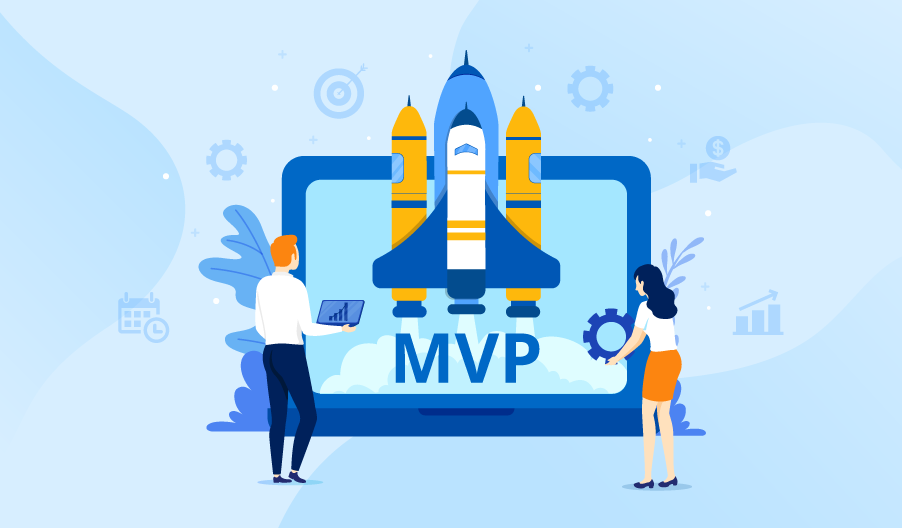In the field of software development, MVP is a technique that is becoming more and more common. It carries very low risk for the product owner and is a very dependable and economical technique to assess a software innovation in actual market circumstances. Therefore, it’s definitely worth a try if you have a creative idea for an application.
For individuals who want to launch a cutting-edge app, we have put together an easy-to-follow tutorial. This tutorial should be helpful for creating any type of MVP, regardless of whether you have your own development team or are looking to hire an MVP developers.
What is MVP?

MVP stands for “Minimum Viable Product,” which refers to a product that has just the essential functions of an application. It is the most practical technique to introduce a product rapidly and acts as a quick and quantitative market test.
When an MVP is made accessible to people, the owners can see their actual response and modify the solution accordingly. If the solution doesn’t function at all, they can also completely trash the idea. Making an MVP is significantly less painful than creating a full-fledged solution since it is much less expensive.
What distinguishes an MVP from a POC and a prototype?

An MVP should not be confused with either a proof of concept (POC) or a prototype, despite the fact that some individuals do so.
The basic objectives of an MVP are to draw first users from a large pool, collect feedback, and begin generating revenue from the product. However, a POC is used to gauge the idea’s technical viability and draw in the first investors.
Prototypes are also very different because their major objectives are to gather feedback from a small initial user base, to refine designs, and to draw in more funding.
What several kinds of MVP exist?
There are four main categories for MVPs:
1.The Wizard of Oz MVP

Similar to its namesake, who employed levers and equipment to pretend he was a magical green head, a Wizard of Oz MVP produces the appearance of an automated process while actually being managed manually.
For instance, the Q&A service Aardvark initially relied on staff members to manually assign users’ inquiries to specialists who could respond to them; the real algorithm that was supposed to handle this from the start was eventually built.
2.MVP Concierge
Concierge MVPs demonstrate that there is a need for the service you are providing by being upfront about their manual nature. The goods itself might not even be real. Food on the Table’s founder initially accompanied his customers to the store, then independently created and sold them customized shopping lists. The service now specializes in developing shopping lists based on the client’s unique preferences.
3.MVP email

Writing an email requires much less work than creating even the most basic software. You can check to see whether potential clients are interested by sending them an email with your concept. You can continue working on the product’s development if the response is favorable. This approach was actually utilized by Product Hunt’s founder, who sent an email with his concept to a list of recipients before deciding it was worthwhile to invest in.
4.MVP landing page
A landing page is a single webpage that introduces your product, highlights its benefits, and includes a button or link that directs users to additional information, a mailing list signup form, a purchase option, etc. This strategy was adopted by Buffer, a business that schedules social media postings during peak traffic hours. The creator spoke with 50 of the signups after reaching 120, gathering a wealth of priceless first-hand input.
How is an MVP implemented?
In essence, an MVP is a product with the bare minimum of functionality. Even while the concept appears straightforward on paper, pinpointing the precise nature of those fundamental components might be difficult. We’ve created a step-by-step guide on putting an MVP into practice because we want you and your development team to find the process as simple as possible.
1. Describe the item

You must first define your product idea in detail. What does it exactly do? What issue does it assist users in resolving? Who are the intended recipients? Make sure each of these questions has a clear response.
2. List the demands for the goods
Make a thorough list of all the features your product must have and consider how it should function. It is advised that you do this with the aid of experts who have knowledge of creating related products.
3. Explain PPR
Your MVP’s PPR, or priority product requirements, provide its foundation. They are the foundational elements of your application, without which it cannot achieve the objectives you established in the first phase. A development team must be consulted in this situation because doing so without them could result in a procedure that is complicated, challenging, and time-consuming.
4.Examine any dependencies

When choosing the functionality of your MVP, keep in mind that features are frequently linked to and rely upon one another. A later stage of development will go more smoothly if these dependencies are taken into account.
5. Begin the construction (if your MVP is a piece of software)
You are now prepared to create the product. Even while MVPs can be developed very quickly and easily, it is nevertheless strongly advised that the product owner be actively involved. Follow the development team’s work, speak with them, give them comments, and offer your own remedies to any potential issues. By doing this, you can make sure that the MVP is a superb depiction of the final product you intend to develop.
6. Start the MVP
Depending on the platform and the type of MVP, there are various ways to launch it once it has been completely tested and finished. Don’t forget to publicize it to draw in the first customers!
7. Deal with the criticism

The entire purpose of an MVP is to gather insightful input from actual users. Obtain and evaluate consumer feedback so that you may adjust your solution. You’ll eventually create a product that fully meets the requirements of both your clients and your company.
Conclusion
The process of creating an MVP seems straightforward, but it actually requires careful planning. The fundamental algorithm of defining its purpose, main features, and dependencies demands your whole focus, regardless of the kind of MVP you’re trying to build.









